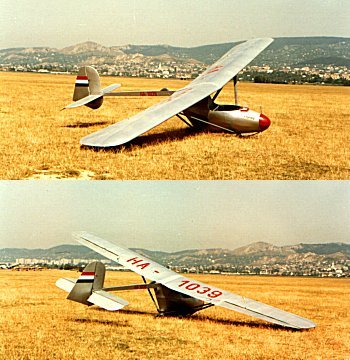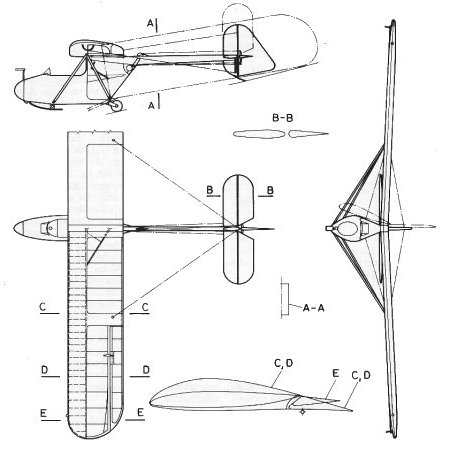HUNGARIAN
GLIDERS
1933-2000
| Type designation: |
R-16b |
| Name: |
Lepke |
| Designer: |
Ernő RUBIK |
| Class: |
Training |
| General arrangement: |
Strutted high-wing, open cockpit, traditional tail unit |
| Crew: |
1 |
| First flight: |
1949 |
| Manufacturer: |
Sportárutermelő Vállalat, Esztergom |
| Number of built: |
65 |

Short history:
The first sketches of a dual-control training glider with side-by-side seat arrangement (Koma) and a single-seater training glider (Lepke), the latter having the same handling characteristics as the two-seater, had been drawn up by Ernő Rubik as early as 1940. His idea was to develop a new training scheme based on gliders having the same handling characteristics and at the same time their construction would be easy and cheap due to similar parts and assemblies. However in the 1940s the financial interests of the Aero Ever Ltd., where his designs had been built, demanded to design and build the R-11b Cimbora two-seater school glider in serial production for the Hungarian Aero Association.
After the war, in 1948, an aircraft-design competition had been announced by the Hungarian National Aviation Association (OMRE), where the Koma design won in the two-seater and the Lepke design won in the single-seater category. The R-16 Lepke prototype first flew at the summer of 1949. After minor modifications the production commenced. The production version got the designation R-16b. During 1952-53 65 Lepke gliders were built. Student pilots got their basic dual training with R-15b Koma, than they flew their first solo as well as their advanced training flights up to gaining their C badges with R-16b Lepke. The last Lepke was withdrawn from service in the middle of the 1960s.
Structure: Mixed wooden-light metal
Wing:
The high-wing glider's all wooden wings were strutted. The struts arrangement was unusual as it had a reversed V form. The rectangle planform wings were rounded off at the tips. The wing was a wooden structure with one main spar and an additional diagonal steel-tube spar at the root. In the wing uniform rib-structures were used since the wing section was constant on nearly the whole span. The wing section and ribs were identical to those of R-15b Koma. The wing in front of the main spar was covered by plywood, and other parts by canvas. The leading edge of the ailerons were of Handley-Page type and the gaps between the wing and the leading edges gradually increased toward the wingtips.
The fittings of the wing connection were formed such a way that it was possible to fold the half wings alongside the fuselage, however to do this the horizontal tail surfaces had to be folded up first. Folding the wings only the fore struts had to be disconnected. It was not necessary to disconnect the aft struts and the control cables.
.jpg)
Fuselage:
The fuselage consisted of a gondola with an open cockpit, and a rectangular shaped aft-beam supporting the tail unit. The canopy with a windshield opened up forward. The gondola consisted of a strong keel and frame, longerons and a steel tube strut supporting the aft-beam. The gondola around the seat was covered by plywood, the other parts by canvas. The landing gear consisted of a skid under the gondola, a fixed wheel located behind the c.g., and a small aft skid made of spring-steel. Standard instrumentation was of a speedometer and a variometer. There was room on the instrument panel to fit in an altimeter as well.
Tail unit:
The tail unit was traditionally arranged. The vertical and horizontal stabilizers' structures were made of wood. The control surfaces structures were built of light metal tube spars with ribs made of light metal sheets. The control surfaces were canvas covered. The tail unit was braced by two cables on both sides to the wings.
.jpg)

| Dimensions: |
| Wing: |
| Span, m: |
10 |
| Area, m2: |
12,84 |
| Aspect ratio: |
7,8 |
| Chord (root), m: |
1,3 |
| Chord (tip), m: |
1,0 |
| Airfoil (root), m: |
Gö 549 |
| Airfoil (mid-span), m: |
Gö 549 |
| Airfoil (tip), m: |
Gö 549 mod. |
| Dihedral, degree: |
3 |
| Sweep, degree: |
0 |
| Washout: |
Aerodynamic |
| Aileron: |
| Span, m: |
2,5 |
| Mean chord, m: |
0,5 |
| Total area, m2: |
1,42 |
| Balancing: |
Aerodynamic |
| Flap: |
| Type: |
None |
| Airbrakes: |
| Type: |
None |
| Horizontal stabilizer: |
| Span, m: |
2,6 |
| Area, m2: |
2,17 |
| Elevator: |
| Span, m: |
2,6 |
| Area, m2: |
1,1 |
| Airfoil: |
Special |
| Balancing: |
None |
| Trim: |
None |
| Vertical stabilizer and rudder: |
| Total area, m2: |
1,26 |
| Rudder area, m2: |
0,62 |
| Balancing: |
None |
| Fuselage: |
| Length, m: |
6,2 |
| Width, m: |
0,6 |
| Height: |
1,33 |
| Cross section, m2: |
0,42 |
| Landing gear: |
| Type: |
Fixed |
| Wheel diameter, m: |
0,26 |
| Masses: |
| Wing, kg: |
? |
| Fuselage, kg: |
? |
| Tail unit, kg: |
? |
| Empty glider, kg: |
80 |
| Gross, kg: |
145 |
| Ballast, kg: |
None |
| Wing loading, kg/m2: |
11,3 |
| Speeds: |
| VNE, km/h: |
110 |
| Max. winch speed, km/h: |
70 |
| Max. speed in rough air, km/h: |
65 |
| Stall speed, km/h: |
42 |
| Performance: |
| Min. sink, m/s (at gliding speed, km/h): |
0,91/50 |
| Best L/D (at gliding speed, km/h): |
14/61 |
| Start methods: |
Bungee, Winch |

Origin of data and 3-view drawing:
Jereb Gábor: Magyar vitorlázó repülőgépek, Műszaki Könyvkiadó, 1988, Budapest
(Gábor JEREB: Hungarian Gliders, Technical Publishing House, 1988, Budapest)
Gábor FEKECS E-mail: fekecs.gabor@t-online.hu

.jpg)
.jpg)
